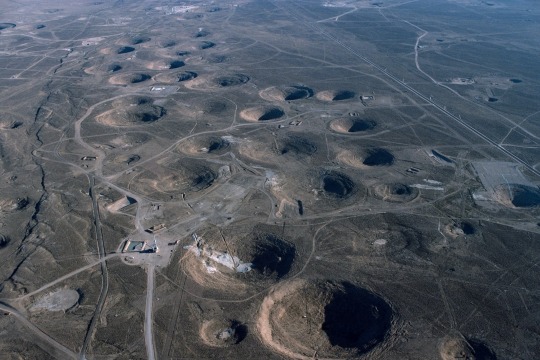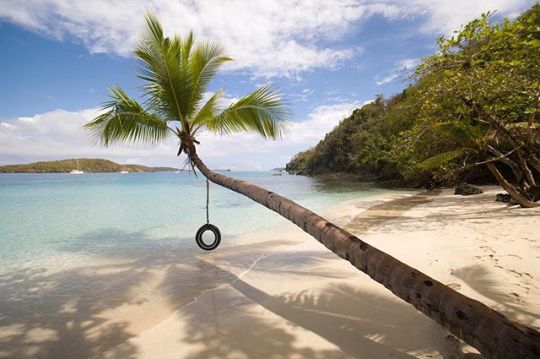#Oppenheimer Beach | St. John | US Virgin Island
Text

The site in Los Alamos, New Mexico, where Robert J. Oppenheimer and his team developed the First Atomic Device in the 1940s is now a United States National Historic Park. It includes structures like this replica of the campus’s main gate. Photograph By Brian Snyder, Reuters/Redux
Trace Oppenheimer’s Footsteps, From New Mexico To The Caribbean
The Father of the Atomic Bomb Chased History—and Then Ran From It. Here’s How to Visit Places Important to the Influential Physicist, Including a U.S. Virgin Islands Beach.
— By Bill Newcott | March 06, 2024
As Christopher Nolan’s film Oppenheimer reintroduces the “father of the atomic bomb” to audiences, there’s no better time to hit the road and retrace some of J. Robert Oppenheimer’s most momentous steps—from New Mexico, where the physicist’s dream of a nuclear weapon was realized in the Manhattan Project; to a Nevada testing ground, where his worst fears about the bomb were demonstrated; to a remote Caribbean beach where he could, at last, quiet the demons that haunted him.
Los Alamos: Birthplace of The Atomic Bomb
The Gadget, as the first atomic device was called by its creators, was born not at Trinity—the New Mexico desert site where it was detonated—but about a hundred miles north, in the sleepy mountain town of Los Alamos. It was there that Oppenheimer, who’d spent some of his teen years in New Mexico, commandeered a former boys’ school as his base of operations.
Oppenheimer’s Manhattan Project campus, now a national historic park, is virtually unchanged from his time.
Strolling along the tree-shaded “Bathtub Row”—so named because these were the few houses on campus equipped with full baths—I walk past the squat bungalow Oppenheimer shared with his wife, Kitty, and their two children. At one end of the street, I nearly brush shoulders with a pair of life-size bronze statues: Oppenheimer—resplendent in his famous wide-brimmed hat—consulting with the project’s military head, General Leslie Groves.
Beyond them I push open the door to Fuller Lodge—the former school assembly hall, now an art gallery and community center—and I am transported into the most riveting moment from the film Oppenheimer.
You remember it: Following the bombing of Hiroshima, the scientist stands before a stone fireplace in this room and gives a victory speech to the Los Alamos staff. But even as he mouths words of triumph, Oppenheimer privately suffers searing visions of the devastation the bomb has caused.
And now, here I am, standing before that same fireplace, facing the long expanse of the room’s ponderosa pine walls and timbered ceiling. It is not hard to imagine Oppenheimer at this spot, in awe of what his team had accomplished in three short years; horrified by its implications for the rest of human history.
Trinity: Site of The First Atomic Blast
Most of the year, Trinity, the site of the first atomic blast, is still an active tract of the White Sands Missile Range, in New Mexico. On two special days, however—usually the first Saturday in April and the third Saturday in October—the U.S. Army hosts a Trinity Open House. (Due to what the U.S. Army called “unforeseen circumstances,” the 2024 April Open House has been canceled).
On those days, vehicles with plates from Alaska to Florida line up at the White Sands Stallion Gate, then bounce the 17 miles south to the circular chain link fence that encloses the spot where Oppenheimer’s Gadget ushered in the atomic age. They park in a seldom used lot and enter through a narrow gate, approaching the stark, black monument at the circle’s center with almost visceral solemnity.
Even in spring, it’s kind of hot here in the treeless, open-air oven the Spanish conquistadors called Jornada del Muerto (Journey of the Dead Man)—but not as hot as it got at precisely 5:30 a.m. on July 16, 1945, when a fireball half as hot as the surface of the sun scorched the earth of this basin.

Tourists at the White Sands Missile Range, in New Mexico, check out an example of the “Fat Man” bomb casing, built to contain a nuclear device. Here at the remote Trinity site on July 16, 1945, the Manhattan Project successfully detonated the first atomic bomb. Photograph By Martin Specht, Agentur Focus/Redux
The 100-foot tower on which the Gadget was mounted is gone, but the Trinity crater remains: a broad, surprisingly shallow, plate-like depression. At its greatest depth the hole that Trinity punched into the desert floor measures only about 10 feet. The 100-foot cushion of air under the tower prevented deeper excavation.
“As a reminder,” a guide tells a clutch of tourists, “you are not permitted to remove anything from the ground.”
“Anything” would be samples of trinitite, the glass-like element that was created in the bomb’s searing blast.
Trinity is the main attraction on visitor days, but the curious can hop a bus to a small cabin, the old Schmidt Homestead, about two miles from Ground Zero. It was here, in the former dining room, where Oppenheimer supervised the final assembly of the Gadget.
With its bare walls and polished floors, the empty house looks as benign as a fixer-upper awaiting a redo by a resourceful real estate agent. But it’s not hard to imagine the team of scientists, just days before the blast, gingerly piecing together the Gadget: A sphere of 32 little bombs surrounding a softball-sized ball of plutonium.
All 32 bombs would be ignited simultaneously. And then, literally, all hell would break loose.
Nevada Test Site
After the war, the U.S. government continued to test nuclear devices of ever more harrowing capability—first in the Pacific, and then at the Nevada Test Site, about a hundred miles north of the then backwater gambling town of Las Vegas. (On the 26th floor of Binion’s Gambling Hall in downtown Vegas, you can still dine in the restaurant where tourists once watched their “Atomic Cocktails” slosh back and forth as nuclear tests made the building sway.)
There is no indication that Oppenheimer ever set foot on the Nevada test site, where more than a thousand descendants of the Gadget were detonated over a span of three decades. Still, the site is essential to Oppenheimer’s story in that it represents his worst nuclear nightmares.
“If atomic bombs are to be added as new weapons to the arsenals of a warring world…then the time will come when mankind will curse the names of Los Alamos and Hiroshima,” he declared in 1945.

A hundred miles North of Las Vegas, the Nevada Test Site is where the U.S. and Britain continued to test Nuclear Devices after World War II. The site is open once a month for a free tour. Photograph By Karen Kasmauski, National Geographic Image Collection
“Basically, Oppenheimer was against nuclear testing post-Manhattan Project,” says Joseph Kent, deputy director and curator of the Atomic Museum in Las Vegas. “He felt the Manhattan Project was necessary, but when they started working on the hydrogen bomb, which was much more destructive, he wasn’t comfortable with that.”
We’re standing in the lobby of the museum, now in its 25th year, just a few blocks from the excess of the Las Vegas Strip. Near the door rests an enormous, bulbous “Fat Man” bomb casing, built in 1945 to contain a nuclear device like the Gadget I saw in New Mexico.
Primarily, the Smithsonian-affiliated Atomic Museum serves as a visitors center for the Nevada Test Site, officially known as Nevada National Security Sites (NNSS). Thanks to the museum’s continuing relationship with NNSS, once a month a busload of 50 or so history buffs leave from the museum’s parking lot to begin a free eight-hour tour of the site.
It begins with an hour drive up US 95, a trip that vividly explains why the site is here: The landscape is a mix of wide, flat valleys, perfect for bomb blasts, interrupted by occasional mountain ranges that would discourage unauthorized watchful eyes.
The highlight is a visit to Sedan Crater: a 300-foot-deep, 1,200-foot-wide crater blasted out by a 104-kiloton bomb to see if nuclear devices could be safely used to dig canals and sea ports. The answer, apparently, was “no, they can’t.”
Your guide will take a group picture at Sedan and send it to you later, but that is the one and only souvenir you’ll get: On the Nevada Test Site tour, you can’t take home rock samples and you can’t bring your camera along.
“Oppenheimer Beach,” St. John, USVI
On the eastern shore of Hawksnest Bay in St. John, U.S. Virgin Islands, a low-slung white structure sits on the broad, sugary sand. The building is a community center, but until just a few years ago, before a hurricane swept it away, a tidy wood cottage crouched there. It had been built in the 1950s by a quiet man who periodically arrived with his wife and family, keeping mostly to himself. In his later years, this is where Oppenheimer escaped the stresses of a world he’d helped create. And Hawksnest Bay is where he and his wife had their ashes spread out.

The sun sets over St. John, in the U.S. Virgin Islands. Oppenheimer and his wife and family spent time at a cottage here on Hawksnest Bay in the 1950s. Photograph By Michael Melford, National Geographic Image Collection
Today, locals call the spot Oppenheimer Beach.
Walking this beach, Oppenheimer could wish away the daily reminders of a nuclear arms race, far from the politicians who had exploited his genius to build the bomb and then, as the Nolan film portrays, turned on him when he expressed regret over his accomplishment.
On St. John, “no one was going to harass him,” local historian David Knight, whose parents house-sat for Oppenheimer during his absences, told the BBC. “No one knew who he was or cared.”
#Los Alamos | New Mexico#First Nuclear ☢️ Bomb 💣#Robert J. Oppenheimer#Los Alamos | Birthplace | Atomic Bomb#Christopher Nolan#United States 🇺🇸 National Historic Park#Atomic Blast 💥#Nevada | US 🇺🇸 States#Oppenheimer Beach | St. John | US Virgin Island
1 note
·
View note
Photo

Oppenheimer Beach St. John, US Virgin Islands . #earthpix #stayandwander #travelphotography #travelstoke #genic_blue #genic_beach #stjohnusvirginislands #oppenheimerbeach #bestplacestogo https://ift.tt/34cgV8K
1 note
·
View note
Photo

Remember the Islands. This is how I left St John in August 2017. I shudder at the images of destruction and loss that has happened there. It's a getaway from reality when one needs it. But it's also a getaway from near by help and supplies. Please donate to help those in need from the destruction of Irma. People are trapped in buildings and need basic supplies.. Islanders don't have easy access to resources. This link by Tim Duncan is to donate and take resources to those in need in the islands. He will match donations up to $1 million. Thank you so much for your help. Please share.. https://www.theplayerstribune.com/tim-duncan-hurricane-irma-us-virgin-islands/. #timduncan #island #remember #dontforgettheislands #donate #supplies #need #help (at Oppenheimer Beach)
0 notes
Photo

Oppenheimer Beach St. John, US Virgin Islands . #earthpix #stayandwander #travelphotography #travelstoke #genic_blue #genic_beach #stjohnusvirginislands #bestplacestogo https://ift.tt/33VV1Xk
1 note
·
View note